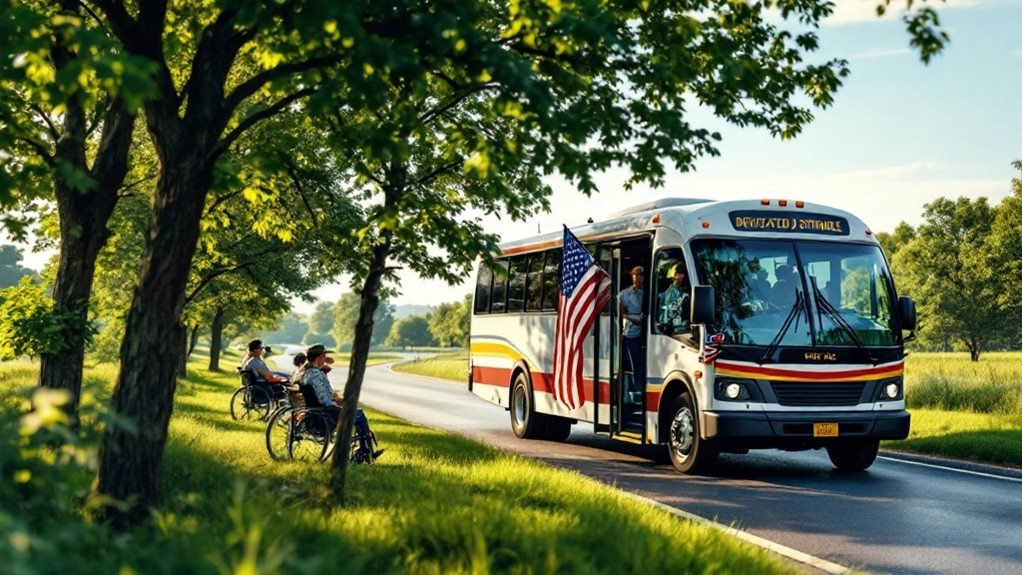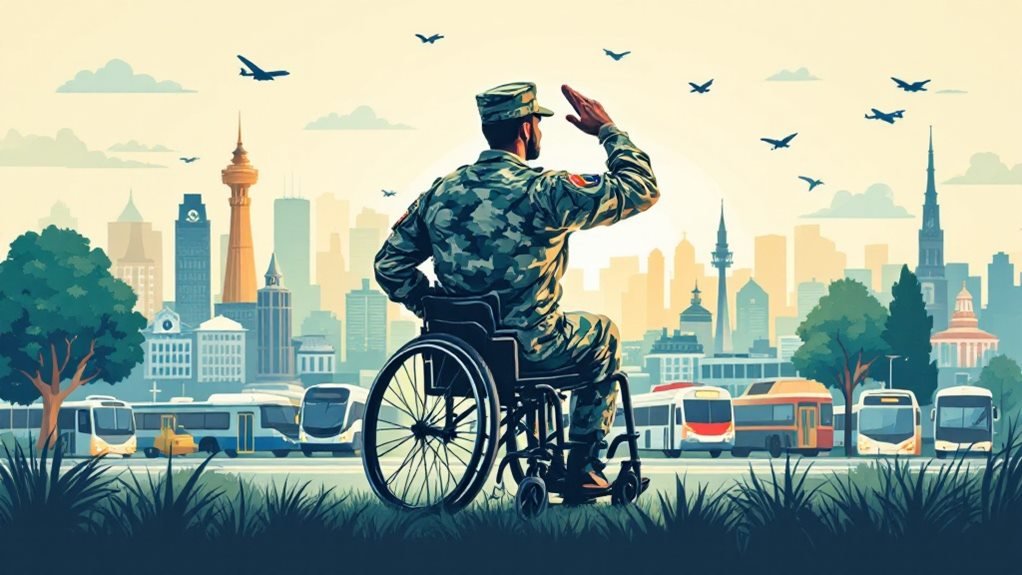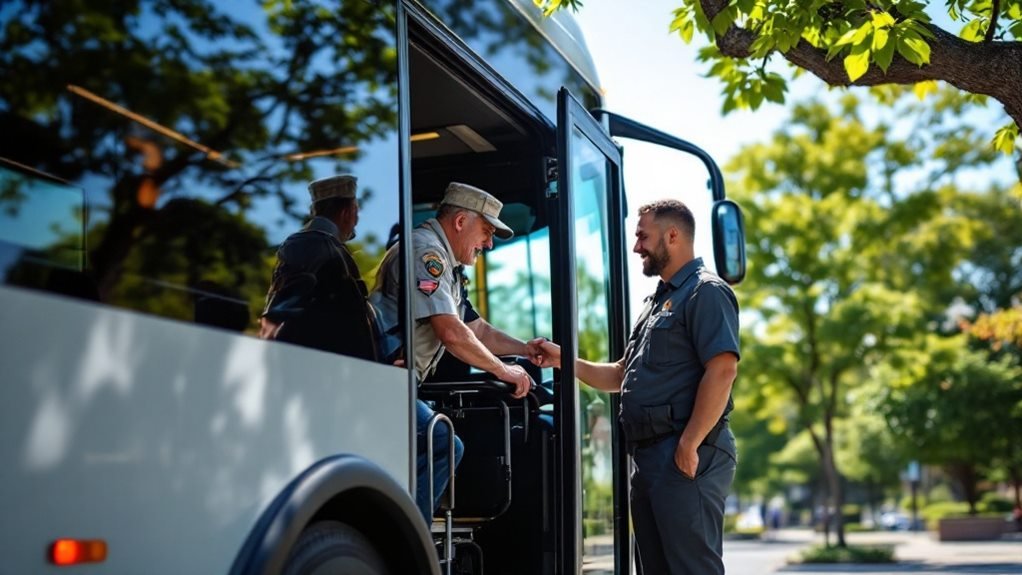Securing a government contract to transport veterans begins with us mastering procurement processes like RFPs and RFQs. We analyze transportation trends and funding sources and guarantee we're registered in databases such as SAM. Certification is critical, so we obtain necessary licenses and, if applicable, SDVOSB status. Crafting a detailed business plan aids in articulating our objectives and understanding logistics. Networking with veteran organizations and attending industry conferences enhances our visibility. Finally, embracing technology for efficiency and guaranteeing compliance with regulations are essential. We're set to explore further strategies and insights that will position us competitively in this field.
Key Takeaways
- Analyze veteran transportation demand trends to align services with genuine needs.
- Verify eligibility and acquire necessary certifications, such as SDVOSB and CDLs.
- Register in SAM and obtain a DUNS number for government contract eligibility.
- Prepare a competitive bid proposal highlighting expertise and understanding of project requirements.
- Network with veteran organizations and attend industry conferences to gain insights and build connections.
Understand Government Contracting Basics
Understanding the basics of government contracting is vital for securing a contract to transport veterans. As dedicated individuals aiming to serve those who've served our country, we must first familiarize ourselves with government procurement processes and contracting terminology.
Government procurement involves acquiring goods and services on behalf of public sectors, and in our case, this means providing reliable transportation services for veterans.
To navigate this landscape effectively, we need a solid grasp of key contracting terms. For instance, understanding the difference between a Request for Proposal (RFP) and a Request for Quotation (RFQ) is essential. An RFP involves detailed proposals and evaluations, while an RFQ focuses on price quotes for specific services.
Being clear on these distinctions helps us respond appropriately and competitively.
Moreover, we must comprehend the implications of contract types, such as fixed-price or cost-reimbursement contracts, as they dictate how we manage costs and deliver services. Familiarity with these terms guarantees that we're not only meeting the requirements but also optimizing our resources to provide exemplary service.
Identify Relevant Contract Opportunities
One essential step in securing a government contract for transporting veterans is to precisely identify relevant contract opportunities.
Let's begin by analyzing current veteran transportation trends. Understanding these trends helps us pinpoint areas where transportation services are in high demand. Are there specific regions where veterans need more frequent transport? Do certain times of the year require increased services due to events like medical appointments or community gatherings? By answering these questions, we can align our services with genuine needs.
Next, we must examine contract funding sources. Government contracts often have designated budgets, and understanding these funding streams is vital. We should explore federal, state, and local government websites, such as the System for Award Management (SAM) and the Federal Business Opportunities (FBO) portal, to find detailed information on available contracts.
Let's not overlook the importance of networking with veteran organizations and agencies. They often have insights into upcoming contracts or unmet transportation needs.
Meet Eligibility and Certification Requirements
Securing a government contract to transport veterans frequently requires meeting specific eligibility and certification requirements.
To start, we must verify that we meet the eligibility criteria set forth by the Department of Veterans Affairs (VA) or other relevant agencies. These criteria often include having a proven track record in veteran transportation, demonstrating financial stability, and possessing the necessary licenses and insurance to operate vehicles safely and legally.
Next, we should guarantee our drivers are properly certified. This involves verifying that they hold commercial driver's licenses (CDLs) appropriate for the types of vehicles used in veteran transportation. Additionally, drivers may need specialized training, such as Passenger Assistance Training, to handle veterans' unique needs compassionately and professionally.
Moreover, our organization might need to obtain certifications like the Service-Disabled Veteran-Owned Small Business (SDVOSB) designation if applicable. This particular certification can enhance our eligibility and competitiveness when bidding for contracts.
Develop a Comprehensive Business Plan
As we commence on crafting a thorough business plan, we must first define our service objectives to align with veterans' transportation needs.
Next, let's analyze market demand by evaluating the current and projected requirements for veteran transport services in our target areas.
Define Service Objectives
Crafting a detailed business plan begins with articulating clear service objectives, an essential step in securing a government contract for transporting veterans. We must first identify and prioritize veteran needs, guaranteeing our objectives align with the unique challenges they face.
Understanding transportation logistics is vital as these elements form the backbone of our service delivery. By clearly defining how we'll address these logistics, such as scheduling, routing, and vehicle maintenance, we lay a solid foundation for meeting veterans' needs efficiently and reliably.
Our service objectives should encompass not only the physical transportation but also the emotional and practical support veterans require. We need to take into account accessibility for veterans with disabilities, reliable communication channels, and punctual, courteous service.
This attention to detail not only fulfills contractual obligations but also demonstrates our commitment to serving those who've served.
Moreover, incorporating measurable goals within our objectives allows us to track progress and guarantee accountability. For instance, reducing travel time, increasing safety measures, and enhancing comfort can be quantifiable targets.
Analyze Market Demand
To effectively analyze market demand for a government contract transporting veterans, we must first gather and interpret relevant data. Our initial focus should be on understanding veteran transportation trends, which can be achieved by examining historical data and current patterns in demand.
We should identify key factors such as geographic concentrations of veterans, common routes, and frequency of travel needs. By doing so, we'll uncover insights into areas with the highest demand for transportation services.
Next, we should employ robust market research strategies to deepen our understanding. This involves engaging with veteran service organizations and government agencies to gain firsthand information about their transportation needs.
Additionally, conducting surveys and focus groups with veterans themselves can provide valuable perspectives on their preferences and expectations.
Analyzing competitor services is equally important. By researching existing transportation providers, we can identify gaps in service and potential areas for differentiation.
This enables us to tailor our offerings to better meet the needs of veterans.
Outline Financial Projections
Having analyzed market demand and understood the needs of veterans, we now focus on outlining financial projections to develop an extensive business plan.
Let's start with a detailed cost analysis. Identifying all potential expenses, from vehicle maintenance to staff salaries, helps us manage them effectively. This lays the groundwork for precise expense management, guaranteeing we allocate resources efficiently and avoid unforeseen financial pitfalls.
Next, we'll tackle revenue forecasting. By estimating potential income from government contracts, we can set realistic financial goals. A well-defined pricing strategy is essential here, balancing competitive rates with the need to maintain healthy profit margins. This confirms our services remain accessible to veterans while supporting financial sustainability.
Securing the right funding sources is another critical step. Whether through loans, grants, or investors, having a solid financial base supports our operational needs and growth ambitions.
We should also focus on maintaining positive cash flow, ensuring we can meet our obligations and fund day-to-day operations smoothly.
Ultimately, our goal is to create a sustainable transportation service for veterans, grounded in precise financial planning and a commitment to serving those who've served us.
Register in Government Databases
Maneuvering the process of securing a government contract to transport veterans begins with a vital step: registering in the appropriate government databases. This registration process is essential for establishing legitimacy and ensuring our eligibility to bid on contracts.
We must begin by enrolling in the System for Award Management (SAM), a central repository where we enter our business details, ensuring we comply with federal regulations. SAM registration not only verifies our business status but also makes us visible to government agencies seeking transportation services.
Next, we should explore the Dynamic Small Business Search (DSBS), a database managed by the Small Business Administration. By registering here, we can highlight our capabilities and align our services with veteran transportation needs. This enhances our visibility and credibility among contracting officers looking for qualified candidates.
Additionally, we must acquire a DUNS (Data Universal Numbering System) number, which serves as a unique identifier for our business. This number is essential for tracking our business history and performance across various government databases.
Prepare a Competitive Bid Proposal
With our registrations complete in the necessary government databases, we now focus on crafting a bid proposal that stands out in the competitive landscape of government contracting.
To achieve this, we must employ competitive pricing strategies that align with our mission to serve veterans while ensuring financial viability. Our pricing should reflect a careful analysis of market rates, operational costs, and the value we offer. Striking the right balance between cost efficiency and quality service is vital.
In proposal writing, clarity and precision are our allies. We must clearly articulate our understanding of the project requirements and demonstrate how our services meet or exceed these needs.
A well-structured proposal includes an executive summary, a detailed scope of work, and a timeline that highlights our capability to deliver on time. Use precise language to outline our team's expertise and past performance in similar contracts, which strengthens our credibility.
Network With Key Industry Contacts
To effectively network within the veteran transportation sector, we should connect with established veteran organizations, which can provide valuable insights and potential partnerships.
Attending industry conferences not only keeps us informed about the latest trends but also opens doors to meet key players in the field.
Connect With Veteran Organizations
Connecting with veteran organizations is an essential step in securing government contracts for transporting veterans. By fostering veteran outreach, we can identify partnership opportunities that align with both community engagement and service quality goals. These organizations often possess a deep understanding of veteran needs and can guide us in tailoring our transportation logistics accordingly.
To initiate this path, we should actively engage with advocacy organizations that champion veteran causes. By doing so, we not only build rapport but also access valuable insights into program benefits that could enhance our service offerings. Collaborating with these groups can also open doors to funding resources, which are significant for expanding our services.
Our focus should be on establishing meaningful connections that prioritize the well-being of veterans while enhancing our operational capabilities. Understanding the specific needs of different veteran demographics allows us to tailor our services more effectively.
By aligning our goals with those of veteran organizations, we can guarantee a mutually beneficial relationship that prioritizes service expansion and quality.
Ultimately, connecting with veteran organizations provides us with a strategic advantage. It guarantees that our efforts aren't only aligned with government requirements but also genuinely serve those who've served the nation.
Attend Industry Conferences
Attending industry conferences emerges as a critical strategy for networking with key industry contacts when seeking government contracts for transporting veterans. By participating in these events, we position ourselves to connect directly with decision-makers and influencers who can provide valuable insights into the contracting process.
Effective networking strategies at these conferences include preparing a succinct elevator pitch, bringing professional business cards, and engaging in meaningful, service-oriented conversations.
We should attend sessions and workshops focused on government contracting, as they often reveal the latest trends and requirements specific to our field. These conference takeaways can guide us in aligning our services with the needs of veteran transportation.
Additionally, panel discussions and Q&A sessions serve as prime opportunities to ask targeted questions, demonstrating our commitment to serving veterans.
Let's not overlook the importance of post-conference follow-ups, which solidify the connections made. Sending personalized emails or messages referencing specific discussions reinforces our dedication and professionalism.
Leverage Social Media Platforms
While industry conferences provide a tangible touchpoint for building relationships, social media platforms offer a dynamic avenue for networking with key industry contacts in the sphere of veteran transportation.
We must develop a robust social media strategy to effectively engage with these professionals and stakeholders. By identifying the right platforms—LinkedIn, Twitter, and Facebook—we can tailor our approach to each audience's preferences and behaviors.
Our content creation should focus on showcasing our commitment to serving veterans through impactful stories, testimonials, and visuals that highlight our capabilities and dedication.
By consistently sharing valuable insights and updates, we not only keep our audience informed but also establish ourselves as thought leaders in the industry. Engaging with posts from key contacts, participating in relevant groups, and joining industry conversations can amplify our presence and foster meaningful connections.
It's essential to monitor engagement metrics and adjust our strategy accordingly. By analyzing which types of content resonate most, we can refine our approach and maximize our outreach efforts.
Social media isn't just a tool for promotion; it's a platform for building lasting relationships that can lead to fruitful collaborations and opportunities in veteran transportation contracting.
Ensure Compliance With Regulations
To successfully secure a government contract for transporting veterans, it's crucial to guarantee compliance with all relevant regulations. We must stay informed about regulatory updates to adapt our operations accordingly. This involves participating in compliance training, which equips us with the knowledge to adhere to legal requirements and implement best practices.
Our commitment to safety standards is paramount, ensuring veterans are transported securely and efficiently. Routine inspection protocols are critical. Regular audits help identify areas needing improvement, allowing us to refine our processes. These audit processes not only maintain compliance but also demonstrate our dedication to excellence.
Legal requirements, such as licensing and insurance, need constant attention. We must ensure that our documentation practices are thorough and up-to-date, supporting both transparency and accountability. Policy changes can occur unexpectedly, and it's our responsibility to adjust promptly.
Keeping a proactive approach allows us to anticipate shifts in regulations and integrate them seamlessly into our operations. By maintaining detailed records and consistently reviewing our procedures, we can confidently demonstrate our ability to meet government standards. Our dedication to these practices not only secures contracts but also honors the trust placed in us to serve our veterans.
Leverage Technology for Efficiency
Leveraging technology is a game changer in optimizing our operations for efficiency. By integrating advanced data management systems, we guarantee precise coordination of routes and schedules.
Route optimization tools enable us to minimize travel time and fuel consumption, enhancing our ability to serve veterans promptly. Mobile applications streamline communication between dispatchers and drivers, providing real-time updates and fostering seamless interaction.
Fleet tracking technology offers us detailed insights into vehicle locations, allowing for quick adjustments and improved accountability. We also utilize performance analytics to evaluate our service metrics, guaranteeing we consistently meet high standards.
Customer feedback is essential, helping us fine-tune our services to better meet veterans' needs. Utilizing scheduling software, we can efficiently allocate resources and adapt to any changes swiftly.
Communication tools keep our entire team connected, guaranteeing everyone is informed and aligned with our mission. Training modules empower our staff with the necessary skills to operate technology effectively and adhere to safety protocols.
Monitor and Maintain Contract Performance
Guaranteeing the contract's success requires our vigilant attention to monitor and maintain performance metrics. We must employ a robust quality assurance framework, guaranteeing that every aspect of our service meets or exceeds expectations. By systematically gathering and analyzing customer feedback, we can identify areas for service enhancement, addressing any shortcomings promptly.
Effective risk management is essential. Regular contract audits help us identify potential issues before they escalate, allowing us to implement corrective actions quickly. By keeping an eye on these audits, we guarantee compliance and continually improve our processes.
Stakeholder communication is another significant component. We must keep all parties informed and engaged, fostering a collaborative environment where concerns are addressed openly and swiftly.
Resource allocation plays a fundamental role in maintaining contract performance. We need to guarantee that our resources are deployed efficiently, ensuring no aspect of our service delivery suffers from neglect. By regularly reviewing our resource distribution, we can adapt to changing needs and demands, ensuring peak service levels.
Conclusion
In pursuing government contracts to transport veterans, we must juxtapose our passion for service with meticulous attention to detail. Steering through regulations isn't just a hurdle; it's our pathway to success. By aligning eligibility requirements with a robust business plan, we guarantee readiness. Let's leverage technology to streamline operations while maintaining performance standards. Networking transforms contacts into allies. Together, we'll not only meet compliance but exceed expectations, turning challenges into opportunities for impactful service.



